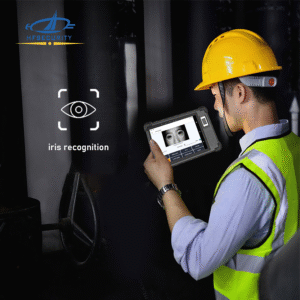An iris scanner uses advanced imaging technology to capture and analyze the intricate patterns of the iris — the colored part of the eye surrounding the pupil. These iris patterns are unique for every individual, even for identical twins, making them an ideal biometric identifier. Iris scanners are now widely used in access control systems, time attendance management, border security, and financial authentication.
How Does an Iris Scanner Work?
The working principle of an iris recognition system is based on capturing a high-resolution image of the iris using near-infrared light. This light highlights the detailed texture and patterns of the iris while minimizing reflections from the cornea.
The captured image is then processed by a biometric algorithm that extracts over 200 unique points and converts them into a digital template. During identification, the system compares the live iris pattern with stored templates in a secure database.
Modern iris scanners feature AI-powered matching algorithms, enabling ultra-fast identification — often in less than one second — with an exceptionally low false acceptance rate (as low as 1 in 1.2 million).
Iris recognition demonstration video
Core Features of an Iris Scanner
1. High Accuracy and Reliability
Iris patterns are unique and stable throughout life, making them far more reliable than fingerprints or facial features.
2. Contactless Authentication
Users simply look into the device; no physical contact is required, making it ideal for hygiene-sensitive environments like hospitals or public facilities.
3. Fast Recognition Speed
Advanced processors and algorithms deliver quick verification, suitable for high-traffic areas like airports, offices, and schools.
4. Liveness Detection
Prevents spoofing using printed photos or videos, ensuring genuine identity verification.
5. Multi-Biometric Integration
Iris scanners can be combined with face recognition, fingerprint scanning, or palm vein authentication for layered security.
6. Adaptability in Different Environments
Works effectively under various lighting conditions, including outdoor and strong light environments.
7. Free SDK & API for Developers
Professional iris scanners, such as HFSECURITY FP08 Biometric Tablet and X05 Access Control System, come with free SDKs for seamless integration into existing security systems.
Applications of Iris Recognition Technology
1. Government and Border Control
Used in e-passports, immigration systems, and national ID programs to enhance border safety and identity verification.
2. Corporate Access Control
Integrated with turnstiles, swing gates, and speed gates to manage entry permissions in office buildings and industrial facilities.
3. Time Attendance Management
Incorporated into attendance machines and biometric software systems like HFSECURITY’s HFIMS, ensuring accurate employee attendance tracking and schedule management.
4. Banking and Finance
Used for secure ATM transactions, KYC verification, and customer identity protection.
5. Healthcare and Medical Records
Provides safe, contactless access to patient records and prevents identity fraud in hospitals and clinics.
6. Education and Research Institutions
Ensures accurate student attendance and access to labs or dormitories.
7. Public Security and Smart Cities
Supports surveillance and identity management systems in smart city applications.
Advantages of Using Iris Scanners in Modern Security Systems
Unparalleled Precision: Iris recognition achieves the highest accuracy rate among biometric modalities.
Non-Intrusive Process: Completely touch-free, ensuring hygiene and convenience for users.
Long-Term Stability: The iris does not change over time, maintaining consistent recognition accuracy.
Scalability: Easily integrated into large-scale security systems and cloud-based databases.
Compatibility: Works with multiple devices and platforms, including Android and Windows.
Customizable Solutions: Manufacturers like HFSECURITY provide OEM/ODM customization to meet specific project requirements.
Iris Scanners and Multi-Biometric Systems
In modern applications, iris recognition is rarely used in isolation. Many organizations prefer multi-modal biometric systems, which combine iris, face, and fingerprint recognition for enhanced security and flexibility.
For instance, HFSECURITY’s FP08 Biometric Tablet integrates iris scanning, facial recognition, and fingerprint authentication within a single portable device. Similarly, the X05 Access Control Device supports iris recognition along with NFC card reading and SMS notifications, making it suitable for enterprise-level access management.
These integrated systems can connect directly to HFSECURITY’s HFIMS software, providing comprehensive control over attendance, visitor management, and access rights in real time.
結論
The iris scanner has become a cornerstone of modern biometric identification. Its high accuracy, hygiene-friendly contactless operation, and powerful integration capabilities make it ideal for industries that demand the highest level of security.
Whether it’s used for government identity projects, corporate access control, financial verification, or smart attendance systems, iris recognition technology offers the perfect combination of security, speed, and reliability.




